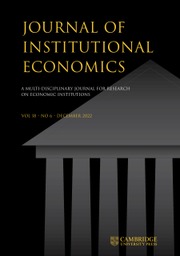Crossref Citations
This article has been cited by the following publications. This list is generated based on data provided by
Crossref.
LOPES, HELENA
SANTOS, ANA C.
and
TELES, NUNO
2009.
The motives for cooperation in work organizations.
Journal of Institutional Economics,
Vol. 5,
Issue. 3,
p.
315.
Elsner, Wolfram
and
Heinrich, Torsten
2009.
A simple theory of ‘meso’. On the co-evolution of institutions and platform size—With an application to varieties of capitalism and ‘medium-sized’ countries.
The Journal of Socio-Economics,
Vol. 38,
Issue. 5,
p.
843.
Pessali, Huáscar
and
Dalto, Fabiano
2010.
A mesoeconomia do desenvolvimento econômico: o papel das instituições.
Nova Economia,
Vol. 20,
Issue. 1,
p.
11.
Fine, Ben
2010.
Beyond the Tragedy of the Commons: A Discussion ofGoverning the Commons: The Evolution of Institutions for Collective Action.
Perspectives on Politics,
Vol. 8,
Issue. 2,
p.
583.
Raudla, Ringa
2010.
Governing budgetary commons: what can we learn from Elinor Ostrom?.
European Journal of Law and Economics,
Vol. 30,
Issue. 3,
p.
201.
THEESFELD, INSA
SCHLEYER, CHRISTIAN
and
AZNAR, OLIVIER
2010.
The procedure for institutional compatibility assessment: ex-ante policy assessment from an institutional perspective.
Journal of Institutional Economics,
Vol. 6,
Issue. 3,
p.
377.
OSTROM, ELINOR
2010.
Organizational economics: applications to metropolitan governance.
Journal of Institutional Economics,
Vol. 6,
Issue. 1,
p.
109.
Clark, Terry Nichols
2010.
Nobel Elinor: Transcending Markets, Bureaucracy, Covenants, and Business Elites.
Transnational Corporations Review,
Vol. 2,
Issue. 2,
p.
79.
CHRISTOFOROU, ASIMINA
2010.
Social capital and human development: an empirical investigation across European countries.
Journal of Institutional Economics,
Vol. 6,
Issue. 2,
p.
191.
Elsner, Wolfram
2010.
The process and a simple logic of ‘meso’. Emergence and the co-evolution of institutions and group size.
Journal of Evolutionary Economics,
Vol. 20,
Issue. 3,
p.
445.
CHANG, HA-JOON
2011.
Institutions and economic development: theory, policy and history.
Journal of Institutional Economics,
Vol. 7,
Issue. 4,
p.
473.
Weng, Ting Sheng
and
Hsu, Meng Hui
2011.
On the Study of Non-Engineering Students Applied Open Source for Learning Graphic Design Skills of Dynamic 3D Motocross Suspension Mechanism.
Advanced Materials Research,
Vol. 328-330,
Issue. ,
p.
892.
BASTAKOTI, RAM C.
and
SHIVAKOTI, GANESH P.
2012.
Rules and collective action: an institutional analysis of the performance of irrigation systems in Nepal.
Journal of Institutional Economics,
Vol. 8,
Issue. 2,
p.
225.
GREENHOUSE, CAROL J.
2012.
The “State Idea” in Theory and Practice.
Reviews in Anthropology,
Vol. 41,
Issue. 3,
p.
154.
ZUMBANSEN, PEER
2012.
Comparative, global and transnational constitutionalism: The emergence of a transnational legal-pluralist order.
Global Constitutionalism,
Vol. 1,
Issue. 1,
p.
16.
Khalil, Elias L.
2012.
WHY EUROPE? A CRITIQUE OF INSTITUTIONALIST AND CULTURALIST ECONOMICS.
Journal of Economic Surveys,
Vol. 26,
Issue. 2,
p.
351.
Tavoni, Alessandro
Schlüter, Maja
and
Levin, Simon
2012.
The survival of the conformist: Social pressure and renewable resource management.
Journal of Theoretical Biology,
Vol. 299,
Issue. ,
p.
152.
Rütten, Alfred
Abu-Omar, Karim
Gelius, Peter
Dinan-Young, Susie
Frändin, Kerstin
Hopman-Rock, Marijke
and
Young, Archie
2012.
Policy assessment and policy development for physical activity promotion: results of an exploratory intervention study in 15 European Nations.
Health Research Policy and Systems,
Vol. 10,
Issue. 1,
Castellano, Fernando López
and
García-Quero, Fernando
2012.
Institutional Approaches to Economic Development: The Current Status of the Debate.
Journal of Economic Issues,
Vol. 46,
Issue. 4,
p.
921.
Zumbansen, Peer
2013.
Transnational Private Regulatory Governance: Ambiguities of Public Authority and Private Power.
SSRN Electronic Journal,

